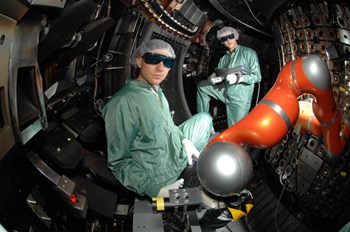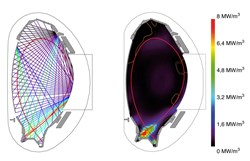ITER NEWSLINE
-
Sophisticated miniatures for ITER
Max Planck Institute of Plasma Physics (IPP)
Sophisticated miniatures for ITER

Bolometer lines of sight being measured in the plasma vessel of the ASDEX Upgrade fusion device by means of a robot (photo: Volker Rohde, IPP)
The contract for developing an important diagnostic method for ITER went to the Max Planck Institute of Plasma Physics (IPP) in Garching, Germany. The European Domestic Agency (Fusion for Energy, F4E) will be funding a German research and industrial consortium, headed by IPP, to the amount of EUR 4.8 million over four years. The objective is the advanced development of so-called bolometer cameras for recording the heat and X-radiation emitted from the ITER plasma. Award of the contract was based on a preparatory phase supported with national project funds in which the participants' suitability for this and other ITER tasks was verified.
The measuring method records the heat and light emission from the infrared to X-ray region and pinpoints their origin in the plasma. The radiation power is part of the total energy balance of the plasma. It has to be known in order to control the plasma or apply certain modes of operation.

Bolometer measurement on the ASDEX Upgrade plasma. On the left the numerous lines of sight of the bolometers, which scan the cross-section of the plasma. Result on the right: The values of the radiation power measured along these lines of sight were used to calculate its origin in the plasma. This ''deconvolution'' or tomographic reconstruction shows that the highest density of the radiation power occurs at the bottom edge of the plasma (the divertor area). As intended, the hot inner plasma scarcely emits any radiation power. (Graphic: Matthias Bernert, IPP)
The measuring principle of a bolometer? A metal plate the size of a postage stamp absorbs the radiation emitted from the plasma along a narrow line of sight, thus heating up. The electric resistance of a conductor located below it changes according to the temperature and is therefore a direct measure of the radiation power. Additional calculations and measured data allow the radiation to be assigned to its origin in the plasma insofar as a sufficient number of bolometers are available. This reveals exactly what site in the plasma has emitted what power.
The method, developed at and patented by IPP, has been successfully applied for many years. However, the ITER large-scale device imposes new requirements: unlike in previous machines, the detectors will have to withstand impinging fusion neutrons and also be capable of working reliably at temperatures of up to 450 degrees.
Read the full Press Release
here.
return to the latest published articles








